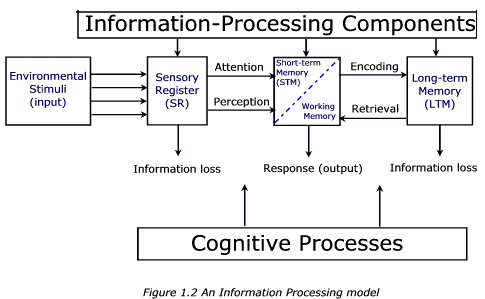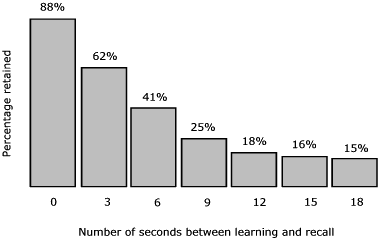|
1.2.1 An Information Processing Model of Learning |
|
To help us learn about the components and processes
involved in an information processing model, we will refer to the
flow diagram below.
In the diagram, you need to trace the flow of information from the inputs on the left, the ‘Environmental stimuli’, following the arrows to the Sensory Register (SR), then through the processes of ‘attention’ and ‘perception’ to the Short-term (STM) and Working memory (WM). From that point an arrow labeled ‘encoding’ continues to the box on the right, the Long-term memory (LTM). The arrow ‘retrieval’ then returns to the WM, and a ‘response’ is created (the output). You will notice that in following the process, information is lost both from the SR and the STM – this is because every day we are confronted with far too much information to process, so it is necessary to pay attention to some and to allow a great deal not to be processed (otherwise we would be overwhelmed with all the demands on our minds). In the diagram, you will also notice that 3 boxes are labelled ‘Information-processing components’ – these are the SR, STM/WM and LTM . These are important basic structures and information is stored and moves between these. The cognitive processes in which we are interested are: attention, perception, encoding and retrieval. We will now describe each of the stages in more detail. An important note for you here is this: although we break down and describe these components and processes step-by-step, they occur in a split-second (very quickly), without us being conscious of them. We hope that as you learn about these, you will become more aware of how you process information, as you watch what comes into your sensory store, what you pay attention to, the things you decide you want to remember, the way in which you rehearse things to assist in memorizing, and how you think about retrieving information from your memory. Environmental stimuli: These are all the things we notice in our surroundings, using our senses. We see, hear, taste, touch and smell a great deal each day. In order for a stimulus to move from our senses to the SR, we need to pay attention to that stimulus – and thus our internal mental process begins. Sensory register (SR): The information from the environment is stored very briefly – often for less than half a second in our SR. What we pay attention to is then important in what happens next. If our working memory is relatively free of work, we might pay attention to the new input. But, if we are concentrating on something else, we don’t notice or quickly forget the new incoming information. (You know this experience – if you are reading something very interesting, although you may know the radio is playing in the next room, you will not ‘hear’ what is played). If the incoming information is of importance to you, you might shift your attention to another stimulus – for example when your sister shouts to you “Supper is ready”. A related process to attention – perception – also plays a role here. We perceive information when we recognize something familiar happening in the environment, or we recognize a pattern of letters, sounds, and so on. Perception is the way in which we try to find meaning in a stimulus. For example, look at the symbols on the next line: - ) : The symbols are a dash, a bracket and a colon. But what do you see if we arrange them as follows? : - ) Someone busy and not interested might simply perceive the same symbols arranged in a different way. If you were interested in the symbols or had experience of working on a computer you may have tried to find meaning in the stimulus and perceived a happy face, two eyes, a nose and a smiling mouth. Some computers automatically change the symbols :-) into a happy face Short-term memory (STM): Paying attention to or perceiving the meaning of a stimulus transfers it to the short-term memory or working memory. Information is stored here for a few seconds – for example if you’ve looked up a telephone number in the book, you store it here so you can dial the number, but then forget the number after a little while. The working memory is like a note pad where we note ideas and work with them, maybe changing their order – so we keep going over the information in different ways in WM to help us think about it. If we don’t process or work with something in STM we quickly lose it. The speed of forgetting is shown in the following graph (Figure 1.3).
Figure 1.3 Decay of information in short term memory
Here we see the performance of learners who learned meaningless sets of three letters called trigrams (e.g. YGM, XJR). When they had to immediately recall these, the average subject remembered 88% of them. After 3 seconds (during which time subjects had to count numbers), they remembered only 62%. After an 18 second interval, only 15% could be remembered. This illustrates how quickly information is lost from STM. In self-activity 1.5 there are some memory tasks for you to try. Long-term memory (LTM): What can we do to assist ourselves and our learners to store important information? In order for information to be transferred to LTM, it needs to be encoded – this means that the information is linked to something we already know, or is re-arranged to make it meaningful. (This is where what we know about schema’s, assimilation and accommodation is helpful). Often it is ‘coded’ by us identifying only ‘key’ or important words that prompt the associated thoughts. In order to store the information for a much longer time, we often need to rehearse, or ‘go over’ the information a number of times in our WM. The LTM seems to have a large capacity, and the information decays over a long time only if we do not access it, or forget how to retrieve it (that is, forget the ‘code’ for remembering it). Retrieval is being able to access the information we have stored in our LTM, so that we can work with it in the WM, or give a response. The decay of memory in the LTM is often related to how meaningful the information is for the learner. If the material has little meaning or is not understood, it decays quickly, often within minutes. If it is linked to facts, it will last a little longer, but if the learner has no interest in the facts, it will be lost. When learners are interested in material, and work with it so that they can describe it in their own words, and revise the material at various intervals in the course, they are much more likely to be able to access it from their LTM. |

